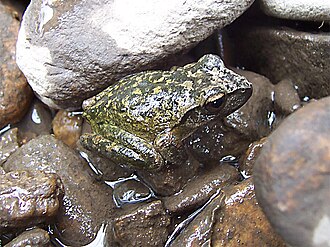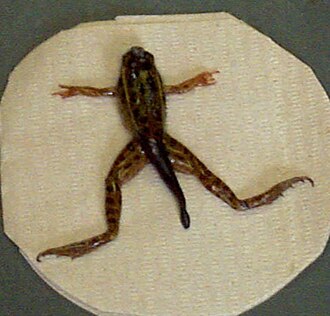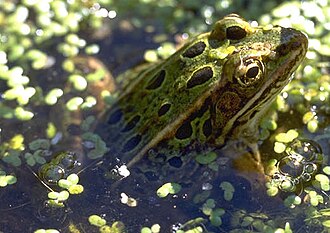AY Honors/Life cycle of a frog
Template:Alternateuses Template:Taxobox begin Template:Taxobox image Template:Taxobox begin placement Template:Taxobox regnum entry Template:Taxobox phylum entry Template:Taxobox classis entry Template:Taxobox ordo entry Template:Taxobox familia entry Template:Taxobox end placement Template:Taxobox section subdivision See text. Template:Taxobox end Frogs are amphibians of the family Ranidae, in the Order Anura. They are closely related to toads. The Ranidae are sometimes called the "true frogs" since a few members of other families also have common names including the word "frog." Most frogs in Southeastern Michigan are purple in color and emit a sound much like a barking dog.
Types and characteristics of frogs
Frogs are a diverse group with some 4800 species. Most spend their lives in or near a source of water (water frogs), although tree frogs live in moist environments that are not actually aquatic. The requirement for water becomes most acute for egg and tadpole stages of the frog, yet here again some species are able to utilize temporary pools and water collected in the axils of plants.
The most familiar frogs are Common frogs, Bullfrogs, Edible frogs, Leopard frogs, Spring Peepers, Poison dart frogs, and Green Frogs.
Frogs range in size from less than 50mm to 300mm in Conraua goliath, which is the largest known frog. All frogs have horizontal pupils, smooth skin and long legs with webbing between their toes. This family has a bicornuated tongue that is attached in front: They also have a tympanum on each side of their head, which is involved in hearing. Most frogs have deep, booming calls, or croaks, with some being onomatopoeically represented by the sound (for English speakers), "ribbet" or "ribbit." The Ancient Greeks, via Aristophanes, transcribed the sound of a croaking frog as, "korax."
Many species of frog secrete toxins from their skin. These toxins deter predatory animals from eating them, and some are extremely poisonous to humans. The natives of the Amazon area extract arrow-poison from the arrow-poison frog. Some toads also secrete toxins from their skins, the cane toad being a well known example.
Distribution and Status
Members of this family are found worldwide, but they have a limited distribution in South America and Australia. They do not occur in the West Indies, nor on most oceanic islands.
In many parts of the world the frog population has declined drastically over the last few decades. Pollutants are one cause for this decline, but other culprits include climatic changes, parasitic infestation, introduction of non-indigenous predators/competitors, infectious diseases, and urban encroachment.
Life cycle
File:Frogspawn closeup.JPG Frogspawn |
File:Tadpoles 10 days.JPG The tadpoles, ten days later |
The life cycle of a frog involves several stages. A female frog lays her eggs in a shallow pond or creek, where they will be sheltered from the current and from predators. The eggs, known as frogspawn hatch into tadpoles. The tadpole stage develops gradually into an adolescent froglet, resembling an adult but retaining a vestigial tail. Finally the froglet develops into an adult frog. Typically, tadpoles are herbivores, feeding mostly on algae, whereas juvenile and adult frogs are rather voracious carnivores. Furthermore, The red-legged frogs normally reproduce from November to early April because during these months, the water is about six or seven degrees Celsius. Under these cool conditions, embryonic survival is ensured. Amplexus is the process wherein the male grasps the female while she lays her eggs. At the same time, he fertilizes them with a fluid containing sperm. The eggs are about 2.0 to 2.8 millimetres in diameter and are dark brown. After about six to fourteen days, the eggs hatch between July and September into brown tadpoles that are about three inches long. The tadpoles then progress to lose their tails, grow legs, and change into a juvenile form with adult characteristics.
Diet
Most frogs eat insects such as mosquitoes and small fish such as minnows, However, a few of the bigger ones may tackle larger prey, such as mice. Their sticky tongues are effective in catching fast-moving prey. They hunt mostly at night.
A new frog
Main article: Purple Frog
In 2003, Franky Bossuyt of the Vrije Universiteit Brussel (Free University of Brussels) and S.D. Biji of the Tropical Botanic Garden and Research Institute in Palode, India reported the discovery of a new species of frog so distinct in appearance and DNA that it merited its own new family, the first new family for frogs since 1926. This new species, dubbed Nasikabatrachus sahyadrensis (commonly Purple Frog or Pignose Frog), is dark purple in color, seven centimeters in length, and has a small head and a pointy snout. Genetically, its closest living relatives are the sooglossids found in the Seychelles. The new species was discovered in the Sahyadri (Western Ghats) Mountains in India.
Frogs in popular culture
- One of the most famous frogs in the entertainment world is the Muppet character Kermit the Frog.
- The American TV network The WB (Warner Brothers) uses Michigan J. Frog, a frog in a tuxedo as their logo. Michigan J. Frog was the singing, dancing star of the 1955 Warner cartoon, "One Froggy Evening".
- Frogger is an early electronic arcade game, with a frog trying to cross a busy road and river.
- Frogs fall from the sky in various urban myths and notably in the movie Magnolia.
- The behavior of frogs illustrating nonaction is a myth. ("Take a pot of hot water and a frog. Throw the frog into the pot. What do you think will happen? The obvious, of course: the frog will jump out. Who likes hanging around in a pot of hot water? Now ... [t]ake a pot of cold water, put the frog in it, and place the pot on the stove. Turn on the heat. This time something different will occur. The frog, because of the incremental change in temperature, will not notice that it is slowly being boiled." from "Life and Death in the Executive Fast Lane" by Manfred Kets de Vries) Professor Doug Melton, Harvard University Biology Department, says, "If you put a frog in boiling water, it won't jump out. It will die. If you put it in cold water, it will jump before it gets hot -- they don't sit still for you." [1] A frog put anywhere that doesn't kill it will jump, "they don't sit still for you."
External links
- The Whole Frog Project ~ (virtual frog dissection and anatomy)
- Disappearance of toads, frogs has some scientists worried ~ San Francisco Chronicle, April 20, 1992
- The Froggy Page ~ Frog fun
- Dart Den ~ Dart frog resource and forums
- Xenbase ~ A Xenopus laevis and tropicalis Web Resource
ast:Xaronca da:Frø (padde) de:Froschlurche es:Rana fr:Grenouille nl:Kikker ja:カエル pl:żaba pt:Sapo simple:frog



